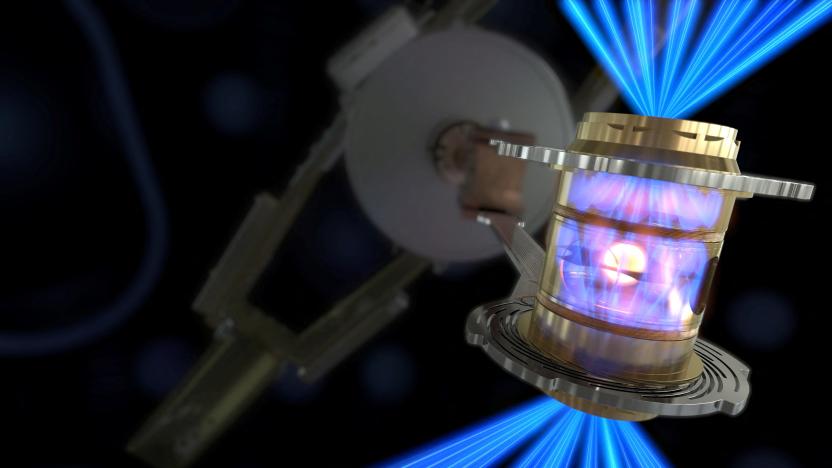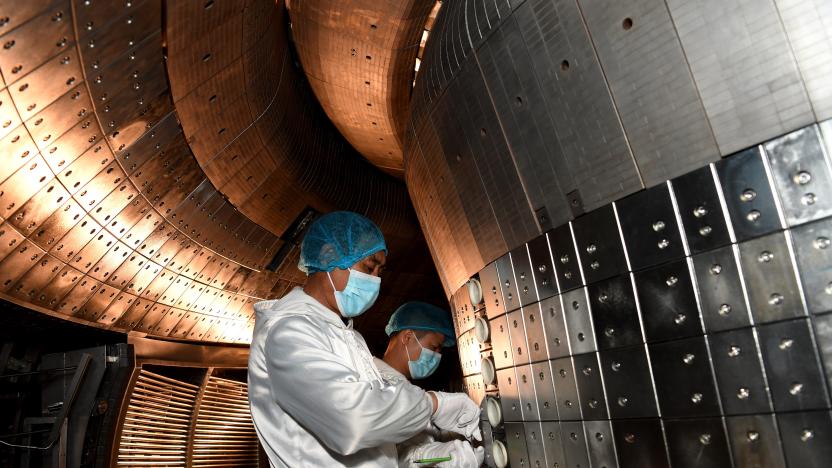lawrence livermore national laboratory
Latest

Scientists have reproduced last year's nuclear fusion breakthrough
Scientists have once again achieved a net energy gain after using a laser to smash two lighter atoms together to create a denser one. The process is said to have a lot of potential as a source of sustainable, low-carbon energy.

Scientists achieve fusion ignition, a major milestone in clean energy production
Fusion power is now much closer to reality after scientists achieved the first reaction with a net energy game.

Fusion power is 'approaching' reality thanks to a magnetic field breakthrough
Scientists have made a magnetic field discovery that could help make fusion reactors a practical reality.

Laser-powered fusion energy inches closer to reality
It just became more realistic to use lasers to generate fusion energy — scientists have sparked a fusion explosion that produced much more energy than before.

Researchers want to store excess renewable energy as methane
One of the major drawbacks to renewable energy sources like wind and solar is that we don't have an effective way to store excess energy. When the wind blows, we might have more than enough energy to feed the grid, but we can't store the surplus. Then, on breezeless days, we're left powerless. As trite as that might sound, it's unfortunately valid, and companies like Tesla have been trying to develop large battery storage solutions. Now, researchers at Stanford University are working on a biology-based battery alternative.

IBM's new computers may change how we process big data
IBM HQ. INT. DAY. An oppressive curtain of rain beats down against the window of this small meeting room in IBM's New York HQ. Two IBM scientists are engaging in excited conversation with a representative from the DEPARTMENT OF ENERGY while a third IBM employee sits at one end, removed from the action, chewing their pen and staring out of the window. DOE REPRESENTATIVE: What do you mean $300 million won't get me the two supercomputers I need? SCIENTIST #1: You're generating too much data. There isn't enough bandwidth for it all to go through. DOE REPRESENTATIVE: I don't understand. You're the supercomputer company, make it happen!

Livermorium and Flerovium take a seat at the Periodic Table
Just when we thought those pesky scientists had stopped messing with the Periodic Table, the International Union of Pure and Applied Chemistry goes and ratifies another two. The pair of elements were discovered in partnership between the Flerov Laboratory of Nuclear Reactions, Joint Institute for Nuclear Research in Russia and the Lawrence Livermore National Laboratory in the States. Element 114 has taken on the spell-check-worrying nomenclature Flerovium (Fl), while 116 becomes Livermorium (Lv). Eagle-eyed readers will notice that both take a name from the labs where they were discovered, the former named after Georgiy N. Flerov and the latter after Ernest O. Lawrence -- both atomic pioneers in their respective countries. The official names will get their first official publication in July's edition of Pure and Applied Chemistry. We guess those textbook makers will be rubbing their hands in glee at all those revised editions it'll sell next term. [Image courtesy of the BBC / Talkback Thames]

GE partners with Livermore Labs to explore efficient aircraft fuel injectors (video)
What would you do with six months of dedicated access to 261.3 teraflops of computational power? As you ponder that question, consider the case of GE Global Research, which has just announced its participation with the Lawrence Livermore National Laboratory in an effort to design more powerful and efficient aircraft engines by way of computer simulation. Specifically, GE will partner with researchers from Arizona State University and Cornell University to study the unsteady spray phenomena that's thought to be ideal for fuel injectors. Through Large Eddy Simulation, GE hopes to discover an ideal spray pattern and fuel injector design, and reduce its number of lengthy, real-world optimization trials. While the research is initially aimed at aircraft engines, the knowledge gained from these experiments may work its way into GE's other products, such as locomotive engines and land-based gas turbines. For a glimpse into GE's current research, be sure to hop the break.

Periodic Table welcomes two new, ultraheavy elements, jury still out on the names
If you bump in to the Periodic Table of Elements today, be sure to give it a hearty Mazel Tov, because it's just welcomed two new members to the family. Yesterday, the International Union of Pure and Applied Chemistry (IUPAC) officially recognized elements 114 and 116, crediting the discovery to scientists from Russia's Joint Institute for Nuclear Research and the Lawrence Livermore National Laboratory, in California. Boasting atomic masses of 289 and 292, respectively, the new man-made additions are now the heaviest elements on record, seizing the belt from copernicium (285) and roentgenium (272). As with most heavyweights, however, both decay within less than a second, making it difficult for researchers to get a grasp of their chemical properties. Nevertheless, both apparently had enough credibility to survive IUPAC's three-year review process, paving the way for the real fun to begin. At the moment, 114 and 116 are known, rather coldly, as ununquadium and ununhexium, respectively, though their names will eventually be jazzed up -- sort of. The Russian team has already proposed flerovium for 114 (after Soviet nuclear physicist Georgy Flyorov), and, for 116, the Moscow-inspired moscovium, which sounds more like an after shave for particularly macho chemists. IUPAC will have the final say on the matter, though one committee member said any proposed names are likely to be approved, as long as "it's not something too weird." Head past the break for a full, and somewhat obtuse PR.

World's largest laser opens for business in California
Another day, another laser... well, not so fast. This particular laser just so happens to officially carry the "world's largest title." Built at Lawrence Livermore National Laboratory in Livermore, California, and housed in the National Ignition Facility -- or NIF -- it was completed at the end of March, and has just now been officially dedicated and opened for business. The laser inside the three-football field-sized building will aim to create a "star" on earth by focusing 192 beams at a pea-sized target, generating temperatures over 100 million degrees and pressure over 100 billion times the earth's atmosphere. The process will create nuclear fusion -- the reaction that powers the sun and the stars. it sounds pretty complicated, and we'd hate to be in town if something goes awry, but we're crossing our fingers for the team! Hit the read link for much, much more information about the project.[Via Physorg]





